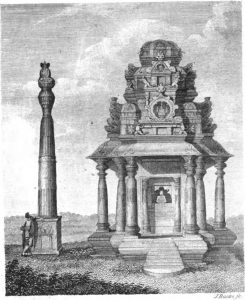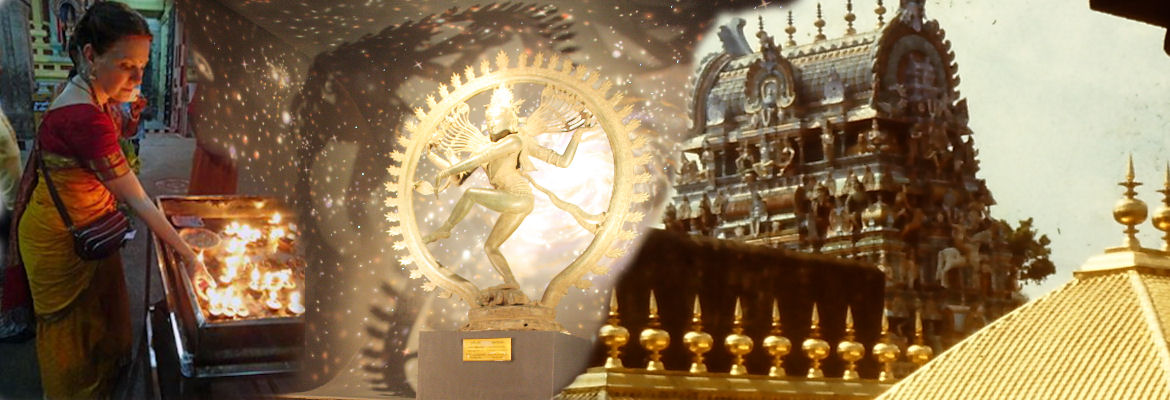This is an excerpt of what is possibly the first ever Western witness about the cave temples at Ellora. This letter dated 1794 from one C.W. Malet to Sir John Shore, President of the Asiatic Society, was published in the 1801 in the sixth volume of the Asiatic Researches or Transactions of the Asiatic Society of Bengal. The letter refers to a contribution to be published, which follows the letter. The article is a description with plates. The interesting part is a reference to two accounts of the history and origin of the caves given in this letter.
The Author C.M.Malet writes:

On this very interesting point, I mean the antiquity of these astonishing works, I shall here trouble you with the different accounts of two intelligent men, one a Mahommedan the other a Hindu. The first, named Meer Ala Khan, an inhabitant of Ahmednugger, who said that he had heard it from a person of acknowledged erudition, but whose name I forgot. The second, a Brahmen, inhabitant of Roza, who quoted a book entitled Sewa Lye Mahat, or the grandeur of the mansion of Sewa, i.e. MAHDEW, as his authority; for the authenticity of which I have hitherto sought in vain.
The Mahommedan says
“the town of Ellora was build by rajah EEL, who also excavated the temples, and being pleased with them, formed the fortress of Deoghire (Doulutabad), which is a curious compound of excavation, scarping, and building, by which the mountains were converted into a fort, resembling, as some say, the insulated temple in the area of the INDUR Subba. EEL rajah was contemporary with SHAH MOMIN ARIF, who lived 900 years ago.”
The Brahmen on the other hand, says,
” That the excavations of Ellora are 7894 years old, formed by EELO rajah, the son of PESHPONT of Elichpore, ·when 3000 years of the Dwarpa Yoag were unaccomplished, which added to 4894 of the present Kal Yoag, makes 7894. EELOO rajah’s body was afflicted with maggots, and in quest of cure, he came to the famous purifying water named Sewa Lye, or, as it is commonly called Sewalla, that had been curtailed by VISHNU (at the instigation of YEMDURHUM, or Jum, the destroying agent) from sixty bows length (each four cuvits square), to the size of a cow’s hoof. In this water, EELOO dipped a cloth, and cleansed with it his face and hands, which cleared him of the maggots. He then built Koond (or cistern) and bathing therein, his whole body was purified; so that, looking on the place as holy, he first constructed the temple called Keylmas, &c. to the place of Biskurma,”
The Koond, or cistern, mentioned by the Brahmens, is extant, and in perfect preservation, just without the town of Ellora, and the holiness of its water is still in such high estimation as to render it s Teerut (pilgrimage) of great reputation and resort, under the appellation of Sewalla Teeruit, of Koond. The neighbouring temples probably form a part of the attraction, as they are much frequented by devout Hindus.
This difference in the era between the Hindu and the Mahommedan, must remain, I fear, inexplicable; while our attention must necessarily attracted to their agreeing in the person of EEL EEA, or EELOO rajah, as the author of the excavations, whose being identified as living in the same age with a well known character, seems to throw the weight of probability into the Mahommedan’s scale; and it must be remarked, that however fond the writers of that faith may be of the marvellous, in points of preternatural agency, according to their own system; yet, as annalists, they seem more entitled to credit than the Hindus, whose historical and theological chronology, is greatly mixed with, and obscured by, fable.
Begging your excuse for this trouble,
I remain, dear Sir,
Your most humble servant,
C.W.MALET
Poonah, 22nd December 1794

Leave a Reply
You must be logged in to post a comment.